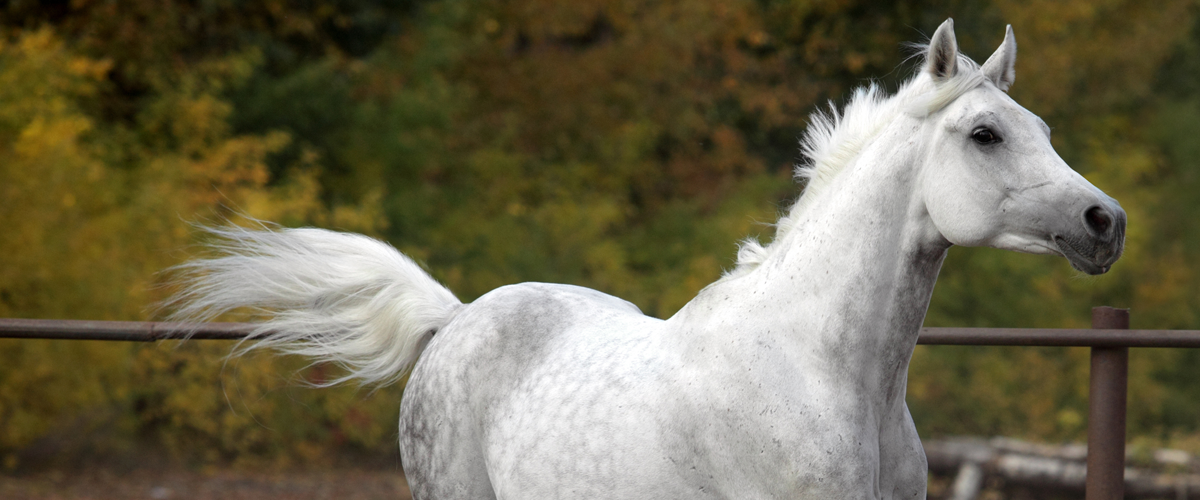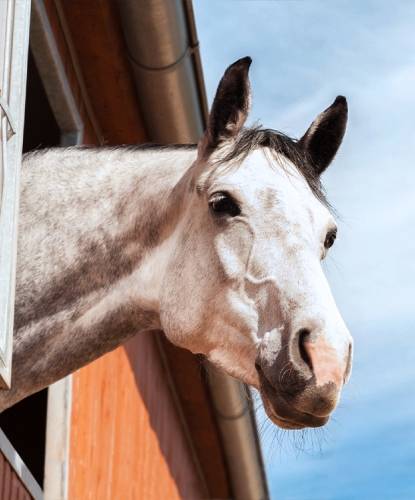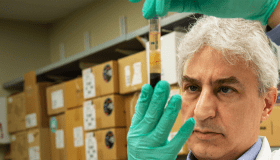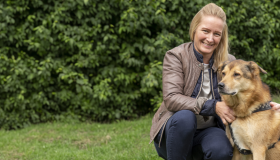
Updated June 15, 2023 – While cancer is not as common in horses as in dogs, cats and people, it still poses a health risk for our equine companions. Many cancers affecting horses are treatable, so monitoring your horse for cancer and seeking prompt veterinary care for any suspicious lumps or bumps can lead to many more healthy years together.
Approximately 80% of reported cancers in horses are associated with the skin or the tissue layer beneath the skin. The three most reported cancers in horses are squamous cell carcinoma, melanoma and sarcoid tumors.
Squamous Cell Carcinoma
It's not often we get to talk about curing cancer, but this possibility came a little closer to fruition thanks to the amazing work of Morris Animal Foundation-funded researcher Dr. Rebecca Bellone and her team at the University of California, Davis.
The group recently identified a genetic mutation for eye-related squamous cell carcinoma (SCC) in Haflinger horses, a breed with a higher reported incidence of SCC.
“The risk factor we have identified is in a gene known to repair UV-caused damage to DNA,” said Dr. Bellone. “We recommend using a UV-protecting fly mask on horses with two copies of the mutation. This is just one example of how understanding the genes involved can be used to reduce the risk of cancer.”
Quick facts about SCC in horses:
- Most common type of tumor affecting the eye and eye structure of the horse
- Second most common cancer found in horses
- Usually locally invasive and slow to spread but can result in blindness
- Often related to sun exposure and more prevalent in regions where solar radiation (ultraviolet rays) is higher
- Risk can be lowered simply by providing shade for your animals
- Most often diagnosed in horses 12 years and older
- High recurrence rate following treatment requires vigilant monitoring
Melanoma
Melanoma is one of the most common types of skin tumors found on horses. This form of cancer is especially prevalent in gray horses, reaching an incidence rate of up to 80%. The tumors, which can be benign or malignant, often are advanced by the time they are diagnosed, and can result in prolonged and significant discomfort for affected horses. Unfortunately, many horse owners are instructed to take a "wait and see" approach when it comes to cancer. One Morris Animal Foundation-funded researcher decided to challenge this approach.
Dr. Jeffrey Phillips, an assistant professor of oncology and medical genetics at Lincoln Memorial University in Tennessee, set out to find practical ways to treat horses with melanoma. He had an interesting proposal – use a recently developed canine melanoma vaccine to treat horses with the disease. Dr. Phillips devised a treatment protocol for horses and received a grant from the Foundation for a clinical trial.
His study was a stunning success. He was able to show dramatic shrinkage of tumors in the majority of horses in the study (15 horses were enrolled in the initial study), and arrested tumor growth in the remaining patients. The horses also developed antitumor immune responses following vaccination. Dr. Phillips’ results are providing hope for thousands of owners whose horses struggle with this debilitating cancer.
Quick facts about melanoma in horses:
- Appears as growth in or under the skin
- Affects about 80% of older gray horses
- In non-gray horses, melanoma tends to be more dangerous
- Arabians and Lipizzaner horses are reported to have a higher disease prevalence
- Typical tumor sites include the underside of tail, genital areas and head
- Canine melanoma vaccine shows promise as treatment for equine melanoma
Sarcoid Tumors
Sarcoid tumors are the most common skin cancer diagnosed in horses and ponies. The good news is these tumors are nonmalignant (they don’t spread to other parts of the body) and seldom fatal. However, they can grow quite large, and spread and multiply locally, impacting the quality of life for affected animals.
Sarcoid tumors come in all shapes and sizes. They can look like circular hairless areas of skin, round lumps, warts, or various combinations. They can be found on any part of the horse’s body, but more often occur near the genitals, on the head or underside of the abdomen. Tumors also can pop up at sites of previous injuries or scarring.
A nearly completed Foundation-funded study is taking an unusual approach to treating sarcoids by using a modified virus usually found in chickens to attack the sarcoid cells. The team was able to show that the modified virus could infect the cancer cells and kill them. The team is finishing a few final tests and hopes to use their findings to develop a new immunotherapy.
Quick facts about sarcoids in horses:
- Most common tumor in horses
- Found anywhere on the body
- Often challenging to treat
- Seldom fatal, but can prevent riding if tumors develop in saddle or bridle area
- Several sarcoid tumor subtypes with some horses having a mixed combination
- A possible link between the development of tumors and infection with bovine papillomavirus
How You Can Help
Of course, studies like these take vision as well as financial investment. And that’s why Morris Animal Foundation, with the generous support of our donors, continues to fund this important work to change the odds for horses suffering from these devastating cancers.
Follow us to learn more about how our funded animal health research is helping horses live longer, healthier lives.
Additional Resources:
Squamous Cell Carcinoma in Horses
Taking on Equine Melanoma and Winning
Watching and Waiting on Equine Melanoma? There's a Better Way
Sarcoid Tumors in Horses
Fresh Scoop Podcast Episode 4: Equine Eye Diseases and Genetic Testing
Horse Health Studies

Want to Learn More About the Health of Horses & Other Species?
Be the first at the stables to hear about breakthroughs in equine medicine. Sign up today to receive AnimalNEWS and other Foundation updates.




